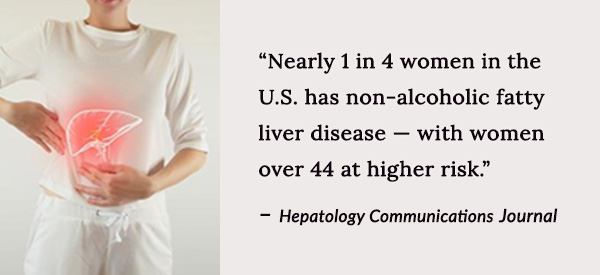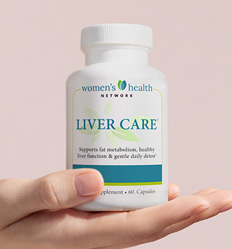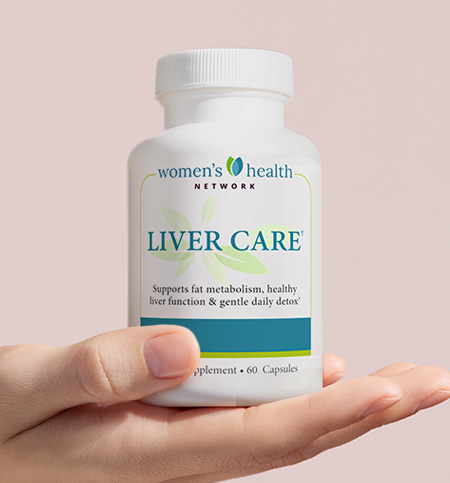Authored by Dr. Mary James, ND
Once upon a time, liver disease was a rare occurrence, mostly affecting alcoholics. But not anymore. Recently, fatty liver disease has become the most widespread chronic liver disease in the United States. If that isn’t shocking enough, consider that fatty liver affects 80 to 100 million people. What’s more, some studies suggest that post-menopausal women are more likely to get it than men. And doctors often miss the early signs and symptoms.

Wondering if your liver is at risk? Fortunately, there are some simple signals that you should check out whenever they appear. The good news is that it’s possible to stop fatty liver in its tracks — and even reverse it completely — if you diagnose it soon enough.
What is fatty liver disease?
Fatty liver occurs when too much fat gets stored in the liver and it can’t function properly. This extra fat also increases inflammation. This is so critical to your health because your liver is a powerhouse organ. It’s responsible for a host of functions in your body, such as controlling your immune system and the clotting of your blood, producing bile and glycogen, detoxifying medications, and filtering toxins out of your body. That’s why it’s so important for you to take the best possible care of your liver.
Your liver also plays a key role in controlling the supply of energy in your body. The sugar (glucose) in your blood is carried into cells by insulin, to be burned for energy. But when glucose can’t easily enter the cells (as in insulin resistance) or when you simply eat more than you need, that extra energy gets turned into fat in the form of triglycerides, which get stored in the cells of your liver.
The same process occurs in people who drink too much alcohol. What starts out as too much fat deposited in the liver can progress to inflammation, liver cell injury and eventually scarring. Various health risks multiply through the stages of fatty liver disease:
- Simple Steatosis: increased total liver fat content (generally above 5-10 percent)
- Nonalcoholic Steatohepatitis (NASH): excessive fat content in the liver, inflammation and some scarring
- Cirrhosis: pervasive scar tissue that significantly impairs liver function
The underlying causes of fatty liver are still being studied and debated. But if you catch the early warning signs, the remedies are well-known.
Surprising signs of fatty liver disease
Especially in its early stages, symptoms of fatty liver can be either non-existent or vague, such as fatigue, fuzzy thinking, mild abdominal discomfort or swelling, and possible irritable bowel syndrome symptoms.
But there are a few well-recognized indicators of possible fatty liver. If any of the following are true for you, it may be time to take steps to protect your liver:
1. Extra weight (being overweight or obese)
2. High (fasting) blood triglycerides
3. High or high-normal (fasting) blood glucose
4. Pre-diabetes (metabolic syndrome)
5. Type 2 diabetes
What do all of these conditions have in common? Nutrition and lifestyle.
Research shows that, above all, obesity is a clear risk factor. Around 70 percent of obese people have fatty liver disease, while only 10 to 15 percent of people with a normal weight have it. But obesity isn’t the only factor.
Fatty liver can also affect women without extra weight
Importantly, though, fatty liver disease also develops in many lean individuals. This makes it easy to miss. If you’re normal weight but you don’t exercise much, and your belly contains more fat than you’d like, you are at risk, especially if your triglycerides are high and your HDL-cholesterol is low. Although 20-30 percent of Americans are thought to have fatty liver, this number rises to 80-90 percent among people with type 2 diabetes or metabolic syndrome (prediabetes).
Menopause and fatty liver
Menopause can also increase your risk of developing fatty liver, since estrogen naturally protects the liver and supports insulin sensitivity. An expanding waist, weight gain and lower energy that causes you to move less all increase the chances of depositing more fat in your liver. Not surprisingly, more postmenopausal women than premenopausal women have been found to have fatty liver disease.
Tips to support your liver
Taking steps in your daily life to eat well and maintain a healthy weight can make all the difference. Simply losing weight (as little as 3-5%) can help to reduce fat, inflammation and scarring in your liver. Aerobic exercise (even moderate intensity) improves the health of your liver, even if it doesn’t lead to weight loss. Exercise and increasing your muscle mass also both help your body to use glucose more effectively.
Here are some tips to support your liver (and your whole body) today:
- Replace trans fats and animal fats with olive, flax seed and avocado oils.
- Choose tofu, fish (preferably wild-caught) or lean fresh meat (organic) instead of fatty or processed meats.
- Eat plenty of vegetables, fruit and high-fiber foods such as beans, legumes and whole grains.
- Limit drinks that are high on the glycemic index (including juice, sport drinks, soda and alcohol). Drink plenty of water instead.
- Swap out white rice, white bread and pasta for brown rice, quinoa or steamed greens. Swap out white potatoes for sweet potatoes.
- Omega-3 fatty acids (e.g., in fish oils) help reduce the abnormalities associated with fatty liver disease, according to several clinical studies.
- Exercise daily, even if it’s just a brisk walk around your neighborhood.
- Do a cleanse at least twice per year. Environmental toxins place significant stress on the liver.
 | Support your liver by losing weight with these natural weight loss tips. |
References and further reading
https://www.ncbi.nlm.nih.gov/pmc/articles/PMC5645706
https://www.cpmc.org/advanced/liver/patients/topics/fatty_liver.html
https://www.self.com/story/millennials-alcohol-related-liver-disease-deaths
https://www.ncbi.nlm.nih.gov/pmc/articles/PMC4837427
https://www.webmd.com/hepatitis/fatty-liver-disease#4
https://www.ncbi.nlm.nih.gov/pubmed/27711128
https://academic.oup.com/jcem/article/96/9/2898/2834715
https://www.ncbi.nlm.nih.gov/pubmed/28941598
https://www.ncbi.nlm.nih.gov/pubmed/29992886












